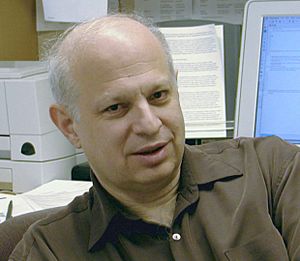Marc Kirschner facts for kids
Quick facts for kids
Marc Kirschner
|
|
|---|---|
 |
|
| Born |
Marc Wallace Kirschner
February 28, 1945 Chicago, Illinois, U.S.
|
| Alma mater | University of California, Berkeley (PhD) Northwestern University (BA) |
| Known for | cell cycle, embryonic development, facilitated evolution |
| Scientific career | |
| Fields | Systems biology |
| Institutions | Harvard Medical School University of California, San Francisco Princeton University |
| Thesis | Conformational changes in aspartate transcarbamylase (1971) |
| Doctoral advisor | Howard Schachman |
| Other academic advisors | John Gerhart John Gurdon |
| Doctoral students | Tim Stearns Tim Mitchison |
Marc Wallace Kirschner (born February 28, 1945) is an American scientist. He studies how cells work and how living things develop. He helped start the Department of Systems Biology at Harvard Medical School. He is known for important discoveries about how cells move and divide. He also studies how embryos grow and how animals have changed over time. Marc Kirschner uses math to understand biology better. He is a professor at Harvard University.
Contents
Early Life and School
Marc Kirschner was born in Chicago, Illinois, on February 28, 1945. He went to Northwestern University and earned a degree in chemistry in 1966. Later, he got his PhD in biochemistry from the University of California, Berkeley in 1971.
Career and Discoveries
After finishing school, Marc Kirschner worked at the University of California, Berkeley and at the University of Oxford in England. In 1972, he became a professor at Princeton University. He later moved to the University of California, San Francisco in 1978. In 1993, he joined Harvard Medical School. There, he led the new Department of Cell Biology. In 2003, he became the first leader of the Department of Systems Biology.
How Cells Work
Kirschner's lab studies many things about cells. They look at how cells divide, how they get their shape, and how they control their size. They also study how embryos develop.
One of his early discoveries was about tiny tubes inside cells called microtubules. He found out how these tubes are built from proteins. He also found a protein called tau that helps keep microtubules stable. Tau protein is important because it's linked to diseases like Alzheimer's.
Cell Division and the Cell Cycle
Marc Kirschner's lab also made big discoveries about the cell cycle. This is the process cells go through to divide. Working with frog eggs, he and Andrew Murray showed that a protein called cyclin helps control the cell cycle. They also found that another molecule, ubiquitin, helps get rid of cyclin when it's no longer needed. This process helps keep the cell cycle on track. His lab found many parts involved in cell division, including the anaphase promoting complex (APC).
Dynamic Microtubules
With another scientist, Tim Mitchison, Kirschner discovered something called "dynamic instability" of microtubules. Imagine microtubules as tiny, flexible rods. In cell division, these rods form a structure called the spindle. The spindle helps pull chromosomes apart.
Dynamic instability means these rods can quickly grow and shrink. If a microtubule doesn't attach to a chromosome, it might suddenly collapse. This allows the cell to reuse its building blocks. This discovery showed how cells can quickly build and change their internal structures.
How Animals Evolve
Kirschner is also interested in how different animal body plans came to be. With John Gerhart, he studied the acorn worm. This worm helped them learn about how different groups of animals, like hemichordates and chordates (which include humans), evolved.
Using Math in Biology
Marc Kirschner is a leader in using math to solve biology questions. For example, he created a math model to understand a cell pathway called the Wnt pathway. This model showed how different steps in a cell's process work together.
His idea to use math in biology led to the creation of the Department of Systems Biology at Harvard. Now, many students from math backgrounds come to his lab to learn about biology. His lab uses math to study how cells signal, how they control their size, and how medicines work.
Books on Evolution
Marc Kirschner wrote two books with John Gerhart. These books explain how cells and development play a role in evolution. They introduced the idea of "evolvability". This means how easily an organism can change and adapt. In their most recent book, they shared a new idea called "facilitated variation." This idea tries to explain how small changes in genes can lead to big, useful changes in complex body parts.
Helping Science
Marc Kirschner has worked to get more money for science research. He helped create a group in 1993 to teach the U.S. Congress about science and ask for public funding. He also helped start a science journal called PLoS Biology in 2003. This journal makes scientific research available for free to everyone.
Awards and Honors
Marc Kirschner has received many awards for his work.
- 1989 - Member, National Academy of Sciences
- 1991 - Richard Lounsbery Award
- 1999 - Foreign Member, Royal Society of London
- 2001 - Gairdner Foundation International Award (Canada)
- 2003 - E.B. Wilson Medal, the highest honor from the American Society for Cell Biology.
- 2015 - Harvey Prize, Technion Institute, Israel.

